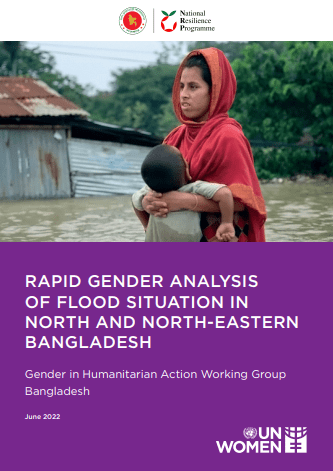Rapid Gender Analysis of Flood Situation in North and North-Eastern Bangladesh
The Gender in Humanitarian Action (GiHA) Working Group in Bangladesh has published a research paper on “Rapid Gender Analysis of Flood Situation in North and North-Eastern Bangladesh” under the UN Women in June, 2022. The research was conducted with the help of the National Resilience Programme (NRP) of the Ministry of Disaster Management and Relief, along with ActionAid, CARE, Oxfam, Save the Children and the United Nations Population Fund (UNFPA).
On May 17, 2022, the Sylhet and Sunamganj districts of the Sylhet division began to experience flooding. Later on, June 17, it took on a more destructive scope and devastated more districts in the Sylhet and Mymensingh divisions. In particular, the districts of Sylhet and Sunamganj were ravaged by the third wave of flash floods that struck Bangladesh in June 2022. As of June 21st, 340,632 people had been relocated to 947 centers in the Sylhet and Sunamganj Districts, according to the Ministry of Disaster Management and Relief. Additionally, 80% of those evacuated were women, young girls, the elderly, and toddlers. The evacuation centers and flood shelters, however, lack the necessary amenities to guarantee the protection and security of women, girls, and children.
All high-rise structures, especially those found in towns and pourashavas, are being utilized as makeshift shelters without the proper safety and security precautions. According to survey results from May 2022, Gender Based Violence (GBV) is perceived as a potential source of mental distress among the afflicted community by 36.2% of Sylhet District respondents and 41.5% of Sunamganj District respondents. Although 140 medical teams are treating patients in the impacted areas, the lack of health professionals, midwives, and birth attendants makes it impossible to satisfy the requirement for safe delivery and other reproductive health services during the crisis.
The research revealed a crucial issue that flood shelters frequently lack separate rooms with facilities for men and women, as well as WASH facilities. In Sunamganj and Sylhet Districts, respectively, 57.3% and 61.9% of women reported physical pain or difficulty in maintaining personal and menstrual hygiene during their time in flood shelters. The main conclusions of the analysis recommend the following immediate actions: reduce GBV and protection risks for the most vulnerable groups; guarantee food security and provide financial support for identified vulnerable groups; and provide life-saving essential services, such as WASH facilities and sexual and reproductive health care.
Click the button below to download the full paper:
Download Gender Analysis of Flood Situation
Source: reliefweb


